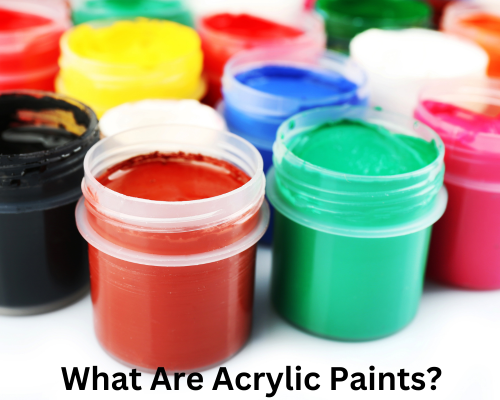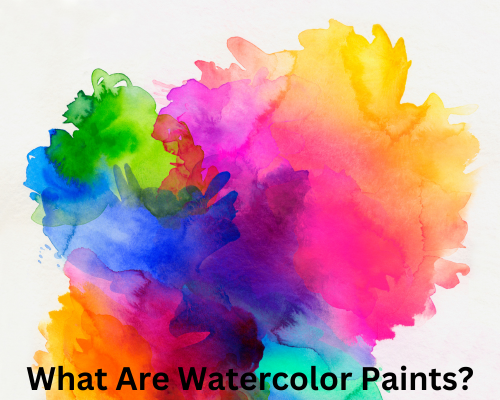Acrylic Vs Watercolor: What Are The Key Differences?
Are you ready to jump on a topic such as acrylic vs watercolor paints? You better be:
The most common advice you probably get daily as a newbie artist is to start your journey with watercolors. Overall, the main reason for someone to offer such advice is the advantages the painting medium provides:
Watercolors are perfect for novice painters since they allow artists to cover large areas fast, dry quickly, and can do wonders when creating thin layers. However, many of these benefits come from using acrylics, too.
Today, I’ll show you the unique advantages of using both mediums and the major differences between them. Let’s get to it, shall we?
Recommended Read:
- 25 Top Acrylic Techniques
- How Should Artists Use Acrylic Paint
- 30 Acrylic Painting Tricks
- What Are Acrylic Mediums?
- How To Start Watercolor Painting
Acrylic Paints Vs Watercolor Paints
Assuming most of my readers are aspiring artists, I want to open this article by covering the basics. So, allow me to cover everything you must know about the similarities and differences between watercolor and acrylic paints.
What Are Acrylic Paints?

Millions of artists prefer acrylic paints when creating original artworks. The question is – do you know what acrylic paints are, though?
Acrylic paints come from pigments suspended in an acrylic polymer emulsion. These pigments provide the paint’s color, while the acrylic polymer acts as a binder (holding the pigment particles together and adhering them to the surface when the paint dries).
Water operates as a solvent in acrylic paints.
Benefits Of Acrylic Paints
As you can guess, we can’t jump straight to acrylic vs watercolor and continue the comparison until you learn the pros and cons of each. Here are the advantages of using the first one when creating an acrylic painting:
- Quick Drying Time: Acrylic paints dry relatively quickly if you compare them to other types of paint, such as oil paints. A fast drying time allows artists to work efficiently and apply multiple layers without extended waiting periods.
- Color Range: Acrylic paints come in many colors, including transparent, opaque, metallic, and fluorescent hues. Subsequently, artists can easily mix them to create custom colors and shades.
- Adhesion: Overall, acrylic paints adhere well to most surfaces, including ones you prepare with a primer or gesso. In other words, these paints are suitable for various artistic applications, including traditional painting, mixed media, and even sculpture.
- Versatility: Since acrylic paints work on many different surfaces, feel free to work with them on canvas, paper, wood, metal, and fabric. They can be applied thickly like oil paints or thinned with water to create translucent washes similar to watercolors.
- Durability: Once acrylic paint dries, it forms a durable and water-resistant surface. Therefore, acrylic paintings are less susceptible to moisture damage.
- Texture: Believe it or not, artists can manipulate acrylic paints to create various textures and effects. Painters can apply them with brushes, palette knives, and sponges or pour them onto the surface for fluid effects.
Disadvantages Of Acrylic Paints
By all means, the advantages you see above are some of the reasons why acrylic paints are the most popular mediums for most artists. After all, acrylic mediums provide painters with vibrant colors, and their unique qualities make them great options to work with.
However, nothing is perfect, and neither are acrylic paints. While this versatile medium is a great choice for some artists, it might not work as well for others. Shall we look at the cons of using acrylic paints?
- They Dry Fast: While the quick drying time of acrylic paints is perfect for most artists, it can be inconvenient for those who prefer more time to work and blend colors on the canvas. Rapid drying may lead to difficulty in achieving smooth transitions between colors, especially for beginners or artists working on larger pieces.
- Opacity and Coverage: You already know acrylic paints come in opaque and transparent varieties, but some colors may have less coverage or opacity than others. Achieving total coverage with transparent or lighter colors may require multiple layers, which can be time-consuming and might obscure fine details in the artwork.
- Color Shift: Unfortunately, acrylic paints can darken as they dry, a phenomenon known as “color shift.” That can make it challenging to accurately predict the final color appearance while painting, as the wet color may differ from the dry color. Artists may need to adjust their color mixing and application techniques for the best results.
- Difficulty with Blending: Again, acrylic paints dry quickly, and blending colors on the canvas might become challenging, especially for artists who prefer to work wet-on-wet. Unlike oil paints, which remain workable for an extended period, acrylics can dry within minutes, limiting the time available for blending and softening edges.
- Toxicity and Fumes: While acrylic paints are non-toxic, some pigments may contain heavy metals or toxic chemicals. Painters should take precautions to minimize exposure to paint fumes and wear protective equipment, such as gloves and a respirator, when working with acrylic paints in poorly ventilated areas or using airbrushing techniques.
- Clean-up and Storage: Cleaning brushes and tools promptly after use is essential to prevent acrylic paint from drying and hardening, which will ruin brushes over time. Additionally, sealing acrylic paint tubes and containers is necessary to prevent them from drying out between uses.
What Are Watercolor Paints?

Watercolor paints are a popular medium among artists, known for their transparent, luminous qualities and fluid application. Considering we can’t move this acrylic vs watercolor comparison until you become familiar with the latter, let me tell you all there is to know about it:
Generally, the watercolor paint consists of pigments suspended in a water-soluble binder, usually gum Arabic. The pigments provide the color, while the binder allows the paint to adhere to paper or other surfaces when water is applied.
Unlike other types of paint, watercolor paints do not contain oils or solvents, making them relatively non-toxic and easy to clean up with water.
Should you use watercolor paint when creating your art? I think you should know all the pros and cons of relying on this medium to make an informed decision:
Benefits Of Watercolor Paints
- Ease of Use: Watercolor paints are relatively easy to use, making them accessible to artists of all skill levels, including beginners. Artists can achieve stunning results with this paint type – that has been the case since ancient times!
- Transparency and Luminosity: These days, watercolor paints are renowned for their transparent nature, allowing light to pass through the layers of paint and reflect off the white paper underneath. This transparency creates luminous, vibrant colors and lends a sense of depth and luminosity to artworks.
- Portability: All watercolor paints are available in various portable forms, including tubes, pans, and liquid watercolors. Pans and travel sets are compact and lightweight, which makes them ideal for plein air painting, travel, or on-the-go artists.
- Layering and Blending: This paint type lends itself well to layering and blending techniques, allowing artists to create subtle gradations, soft transitions, and complex color harmonies. Wet-on-wet painting techniques produce beautiful, ethereal effects, while wet-on-dry techniques allow for precise details and controlled layering of colors.
- Minimal Cleanup: Unlike oil paints, you can easily clean your watercolor painting with water. Rinse brushes and painting tools gently with a little water – they’ll be good to go for a long time.
- Economical: Nowadays, watercolor paints are relatively affordable compared to different mediums. That makes them an excellent choice for artists of any skill level and painters on a budget.
Disadvantages Of Watercolor Paints
Both acrylic and watercolor paints are water-based paints. As you can see, the advantages of these two painting mediums are similar.
However, choosing to work with watercolor instead of acrylic color is a decision you should make after becoming familiar with the disadvantages watercolor artists face. Here they are:
- Permanence: Unlike other painting mediums like oils or acrylics, watercolors are more susceptible to fading over time, especially if you leave them in direct sunlight. Proper framing and storage can mitigate this issue, but it’s still a concern for many artists.
- Drying Time: Watercolors dry quickly, which can be advantageous for some artists but problematic for others. It limits the time for blending and layering, requiring artists to work efficiently and decisively.
- Paper Selection: Watercolor painting requires special watercolor paper that can handle the wetness of the medium. Using the wrong type of paper can result in warping, buckling, or even tearing, affecting the overall quality of the artwork. At the end of the day, that’s not the situation with acrylic paper!
- Different Levels Of Transparency: Watercolors are inherently transparent. Once a color is applied, it’s challenging to completely cover it up without altering the texture or appearance of the painting.
- Staining: Watercolor pigments tend to stain the paper, making it difficult to remove mistakes. While some artists appreciate this characteristic for its unique effects, it can be frustrating for those seeking more control over their work.
Acrylic Vs Watercolor: What Are The Main Differences?

At this stage of this article, you already know the essential facts about the two popular painting mediums – acrylics and watercolors. It’s time to look at the key differences between them.
In other words, let me show you the different things you can expect when working with acrylic and watercolor paints so you can choose the right type of paint for your artwork.
1) Versatility
Acrylic paints are versatile – they work on a variety of surfaces, including canvas, wood, paper, fabric, and more. They can also be applied thickly like oils or thinned to create watercolor-like effects.
Meanwhile, watercolor paints are primarily used on paper, specifically watercolor paper. They are well-suited for various techniques like washes, glazing, and wet-on-wet painting.
2) Layering
Generally, acrylic paints can be layered easily without reactivating the underlying layers once they are dry. That allows for more freedom in correcting mistakes and building up textures.
And watercolor paints operate similarly, but you must apply each layer to avoid reactivating the underlying layers. You’ll have to do more planning and precision when working with transparent washes.
3) Opacity
As you already know, acrylic paints are typically opaque or semi-opaque, although they can be thinned with water to achieve transparency.
But watercolor paints are transparent by nature, allowing the white of the paper to show through the layers of paint, creating luminous effects.
4) Cleanup
By all means, acrylic paint is an art medium that is water-soluble when wet but becomes water-resistant when dry. Such paints can be easily cleaned up with a certain amount of water water and soap.
Yet, watercolor paints are water-soluble when wet and dry, making them easy to clean up with clean water at any stage of the painting process.
Acrylic Vs Watercolor: Final Say
Hopefully, you already know the primary difference between watercolor and acrylic paints. These two mediums have unique characteristics – knowing them is the best way to achieve ultimate results with each brush stroke or palette knife.
In conclusion, I can advise you to choose carefully your working mediums – using fluid acrylics or watercolor paints will help you create different effects.
What questions do you have about this topic? Don’t hesitate to share them with me to receive your answer!